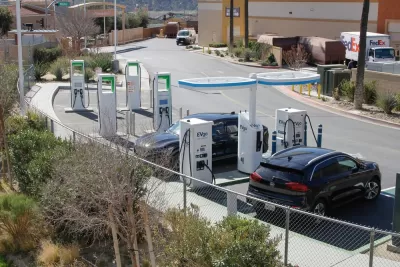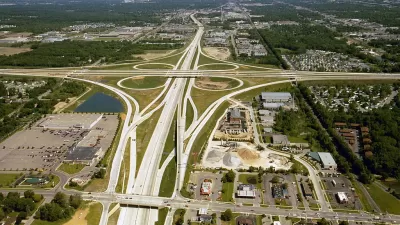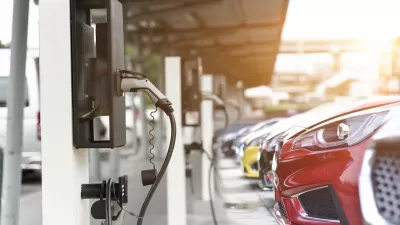EVs are great, but they’re not perfect. Let’s end their free ride.

The rise of electric vehicles in the past year has delivered good news for the climate crisis. EV sales more than doubled in 2021, and have continued to increase in 2022, helped along by the skyrocketing price of gas.
EVs are a huge leap forward environmentally. They emit only one-third the carbon of gasoline vehicles and have no tailpipe emissions of particulates or other dangerous local air pollutants.
So this might sound odd, but now is a good time to make EVs pay to use public roads.
Why? EVs are great, but they’re not perfect. EVs still congest roads, and their large batteries make them heavy—the electric Ford F-150 weighs over 1,500 pounds more than its internal combustion counterpart. Not every electric vehicle is a behemoth, but automakers like Nissan don’t even sell their smaller EVs in the United States. Heavier vehicles are much more dangerous in crashes, and also emit more pollution from brake friction and tire wear. Each mile driven in an electric vehicle imposes social and environmental costs on all of us.
Of course, people who drive gasoline-powered cars also impose these costs. The difference is that we tax gasoline, and gas taxes make drivers pay for some of the social and environmental costs they create. While U.S. gas taxes are low by international standards, they still nudge drivers to buy lighter and more fuel-efficient cars, drive them less, and drive them more slowly. Gas taxes reduce the risk to pedestrians by making people think twice about buying a large, heavy SUV–by one estimate, a 20 percent increase in gas prices pushes SUV sales down about 1 percent. At the same time, the gas tax provides $25 billion a year to maintain and expand the transportation system.
Electric vehicles, in contrast, have been largely shielded from transportation taxes. Quite the opposite–EVs have been generously subsidized. Tax credits lower their purchase price, cities and states install or fund some of their charging infrastructure, and governments and businesses have offered a raft of other incentives to make owning and operating EVs more attractive. Also add fuel economy credits to this pile. Firms like Tesla sell these credits to other manufacturers to shore up their bottom line. In 2021, Tesla’s net sales were $5.5 billion; it earned $1.5 billion selling credits, not cars.
We aren’t criticizing these incentives; many were needed to kickstart the EV market. Subsidies gave manufacturers the certainty to invest in battery research and build or retool production lines, and encouraged early adopting consumers to spend more on an unproven technology. There are good arguments, moreover, for keeping some subsidies that encourage EV purchases. Consumers remain worried about driving range and the availability of charging (particularly in multi-unit apartment buildings), and well-placed government programs could help alleviate these fears.
But it’s also true that times have changed; the EV industry isn’t the vulnerable hatchling it once was. Right now, electric car manufacturers cannot meet demand. VW is “basically sold out” for the rest of 2022. In December, Ford stopped taking reservations for its electric F-150. GM says it will stop making gasoline-powered vehicles by 2035. Industry observers call the electric revolution “unstoppable.” It isn’t crazy to think that most cars, in the not-too-distant future, will be electric.
Even if that’s wrong, and there’s a case to continue subsidies for owning an EV, it should not stop us from ending subsidies for using them. Once an EV is on the road, it is more than competitive with an internal combustion vehicle. Even after a drop from their early summer highs, gas prices right now still average about $4 a gallon, which means an average U.S. car or light truck will burn more than 15 cents of fuel to drive a mile. Comparisons with electricity are imperfect, since electric costs will depend on where and how a car is charged, but a simple rule of thumb suggests the same mile in an EV will cost just 5 cents.
High gas prices represent a turning point: without jeopardizing the gasoline-to-electric transition, we can stop subsidizing electric driving, and start pricing it. Policy no longer needs to turn a blind eye to the social costs of using EVs—the congestion, the traffic deaths, and the (smaller but real) air pollution. EVs impose costs, and their drivers should account for those costs.
What’s more, priced electric driving offers a platform for us to price all driving in a way that more accurately reflects its total costs. The gas tax is a crucial instrument (we shouldn’t get rid of it) but also a blunt one. It helps capture the cost of burning fuel but doesn’t differentiate between miles driven on uncongested rural roads, where the air is clean, and those driven in city centers, where pedestrians outnumber cars and the social costs of automobile use are immense. We now have technology that lets us draw these distinctions, and we should use it.
Some cities are already moving in this direction: New York, Los Angeles, and Vancouver, among others, are considering road user charges. More, hopefully, will follow suit, but the process is slowed by understandable concerns about equity, technology, and, of course, politics. Pricing electric driving could avoid some of these concerns while also familiarizing cities and citizens with the technology. The best time to start is now, when electric vehicles are relatively few and generally owned by affluent people. When this charge is up and running, we can allow cities to piggyback on it and pricing road use by all vehicles in congested urban areas.
A broad program of new vehicle charges is obviously a big political lift. There are numerous details to resolve, and the devil is in many of them. But we can start small–with a per-mile charge for electric vehicles. The charge should be higher for heavier EVs, to account for their higher pollution levels and greater danger to pedestrians. Governments must continue to nurture the transition to electric cars: it must always be cheaper to drive an electric car than a gasoline one. But “cheaper” doesn’t mean “free.” The price to drive an electric car on public roads no longer needs to be zero.
Adam Millard-Ball is a professor of urban planning at UCLA, where he focuses on transportation and climate change.
Michael Manville is associate professor of urban planning at UCLA, where focuses on transportation, land use and housing.

Study: Maui’s Plan to Convert Vacation Rentals to Long-Term Housing Could Cause Nearly $1 Billion Economic Loss
The plan would reduce visitor accommodation by 25,% resulting in 1,900 jobs lost.

Placekeeping: Setting a New Precedent for City Planners
How a preservation-based approach to redevelopment and urban design can prevent displacement and honor legacy communities.

Using Old Oil and Gas Wells for Green Energy Storage
Penn State researchers have found that repurposing abandoned oil and gas wells for geothermal-assisted compressed-air energy storage can boost efficiency, reduce environmental risks, and support clean energy and job transitions.

Washington State Plans Ambitious ‘Cycle Highway’ Network
The state is directing funding to close gaps in its existing bike network and make long-distance trips more accessible.

Homeowners Blame PG&E for Delays in ADU Permits
The utility says it has dramatically reduced its backlog, but applicants say they still face months-long delays for approvals for new electrical work.

Rethinking Wildfire Defense: How a Landscape Approach Can Protect Neighborhoods
Post-fire analysis of the Eaton Fire reveals that a landscape approach — including fire-resistant vegetation, home hardening, and strategic planning — can help reduce wildfire risk, challenging assumptions that trees and plants are primary fire hazards.
Urban Design for Planners 1: Software Tools
This six-course series explores essential urban design concepts using open source software and equips planners with the tools they need to participate fully in the urban design process.
Planning for Universal Design
Learn the tools for implementing Universal Design in planning regulations.
Borough of Carlisle
Caltrans
Heyer Gruel & Associates PA
Institute for Housing and Urban Development Studies (IHS)
City of Grandview
Harvard GSD Executive Education
Salt Lake City
NYU Wagner Graduate School of Public Service
City of Cambridge, Maryland





























